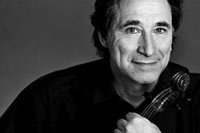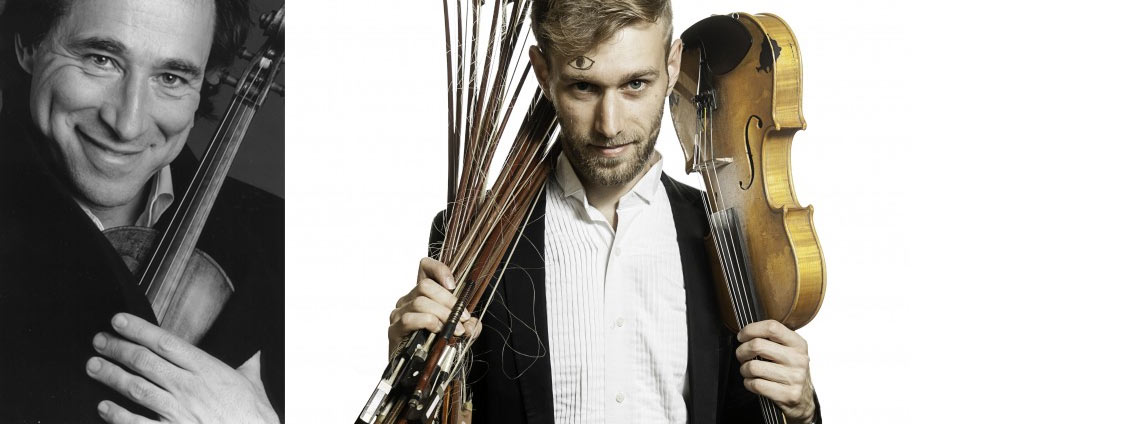The Fox Cabaret | Map
Jaron Freeman-Fox, violin; Marc Destrubé, violin
“While some musicians pigeonhole themselves into tiny sub-genres, Freeman-Fox blows away all walls.” Now Magazine
“Marc Destrubé bared his soul without reserve, yet displaying gentlemanliness and humility”. Early Music News, Australia
Renowned baroque violin specialist Marc Destrubé and his former student, genre-breaking fiddler Jaron Freeman-Fox, share the stage, exploring beautiful variation-based compositions for solo violin by Bach, Biber and Baltzar, along with Jaron’s variations and improvisations and electro-acoustic re-imaginings of these.
PROGRAMME
Thomas Baltzar (c1630-1663)
A Prelude for the violin, in G major
from The Division Violin (London, 1680)
Heinrich Ignaz Franz von Biber (1644-1704)
Passacaglia
from Mystery (or Rosary) Sonatas (Salzburg, c1676)
Intermission
Johann Sebastian Bach
Partia for solo violin No. 1 in B minor, BWV 1002
from Sei solo a violino senza basso accompagnato (Cöthen, 1720)
• Allemande
• Double
• Corrente
• Double
• Sarabande
• Double
• Tempo di Borea
• Double
PROGRAMME NOTES
This program is based on three early works for unaccompanied violin, all of which reflect the idea of variation or improvisation in some form. Baltzar’s ‘Prelude’ was published in an early work of ‘division’ violin music, divisions being the art of taking a simple melody and ‘dividing’ or embellishing it with faster rhythms based on the same melody. Biber’s Passacaglia, the last work in his cycle of ‘Rosary’ Sonatas, is based on a repeating four note line which is the same bass pattern as that of the first line of a hymn to the Guardian Angel. Bach’s b minor partita comprises four dance movements, each of which is followed by a ‘double’. ‘Double’ was a French term used during the 17th and early 18th centuries for a technique of variation in which more or less elaborate ornamentation was added to the original melody, while the supporting harmonies remained the same (the unadorned version of the melody being called the ‘simple’). The term double is thus equivalent to diminution (or division).
Some years ago I was asked by a friend, the composer Peter Hannan, if I would be willing to give lessons to a young violinist who had enrolled at Vancouver Community College. Jaron had never had formal violin lessons from what I could tell, but had grown up, home-schooled, travelling from one fiddle camp to the next. I agreed to meet with him to see if I might be able to help him. When we met and I heard him play, I quickly realized that I would be the one learning from him, but of course I didn’t tell him that, and enthusiastically agreed to take him on. He arrived every week bursting with questions, about music, about left-hand technique, about sub-harmonics, about tuning and temperament, and shared with me his latest discoveries, not to mention his phenomenal violin technique and fertile imagination. He then went off to India to study Indian violin, and later landed in Toronto to take on the mantle of his mentor, the great fiddler and inspiration to a generation Oliver Schroer. Ever since then I looked for an opportunity to share a stage with him. I also looked for an opportunity to perform some solo Bach in a situation that was a little less intimidating that the ‘normal’ concert platform; with many thanks to Matt White and Dave Pay, these two wishes have come together in this project, and the hope is that Jaron’s ‘re-imaginings’ of the music of these three composers will make us aware that the apparent gulf between musical genres is really only a tiny stream (in German: Bach).
– Marc Destrubé
It has been a huge honour and wonderful challenge working on these pieces.
I have always been fascinated with the traditions of solo violin music from around the world. Over the last several years I have gradually developed a new system of expanding the range of my violin to include lower registers, without compromising the freedom of improvising on the instrument acoustically. In this concert I have been able to combine these various pursuits.
However, it is in the re-imaginings of Bach’s music where the real challenge has been, as his music is so bullet-proof, that it has felt neigh impossible to think of any reason to adjust a single note. Therefore, my process has been to memorize his music one small fragment at a time, as if I was trying to trick my ears into thinking I was actually writing the music as I learned it. Once the pieces were memorized, I repeated them extensively, until small improvisations began to peek out from within these bullet-proof constructs that JSB so cunningly designed.
The things I learned working under Marc are still the cornerstones of what I consider playing the violin to be all about. Beyond his inspiring technique and facility of expression on the instrument, he is one of the only violinists I’ve met who is so acutely aware of the why and how of the instrument. For example, how the string plays the bow as much as the bow plays the string, and how the bow relates to our breath. It’s a great privilege to share the stage with him, and a gift to continue learning about my instrument from this mentor 10 years after my first lesson him.
– Jaron Freeman-Fox
Presented in cooperation with Music on Main. Generously sponsored by Ingrid Söchting.

Jaron Freeman-Fox, violin
Scampering about the islands and mountains of northwest BC, Jaron’s early life was nomadically spent moving from festival to festival, busking, house-sitting, harvesting, home schooling, and the occasional van ride across the continent. At age 14 Jaron began a close apprenticeship with the fiddler/composer Oliver Schroer, which lasted until Schroer’s death from Leukemia in 2008.
At age 17, Jaron went on to music school in Vancouver where he studied jazz, composition, as well as classical performance under the renowned classical violinist Marc Destrube. Soon after migrating to the city, Jaron was touring with artists such as The Paperboys, Shane Koyczan, and Tambura Rasa.
In 2007, Jaron began a long-term study in India to pursue his love of Indian classical music. While studying with India’s top violinists (A. Kanyakumeri, Dr. Narmadha, Dr. Balaji) Jaron was soon also performing alongside great artists themselves such as T.V. Gopalakrishnan (well known for his workwith George Harrison and Pandit Ravi Shankar), and John Anthony (the original guitarist for L. Shankar).
After moving to Toronto, Jaron was soon performing with all forms of artists from The Good Lovelies, to Autorickshaw, to Peter Katz and is incessantly working as a session musician, composer, producer and collaborator, providing the music for dance with HYPERLINK “http://www.catalysttcm.com/jameskudelka.html” \t “_blank” James Kudelka, multimedia theatre by Heather Hermant (aka Rotery Poet), storytelling by Dan Yashinsky, film soundtracks by Rich Pell and even a Canadian Tire Commercial and iphone video game by Click Gamer.
Jaron enjoys long stumbles on the beach, early-morning bedtimes, and unrehearsed fire juggling. Jaron cannot tell his left from right except when airborne, and is incapable of walking past shoes left out on the street without at least trying them on.

Marc Destrubé, violin
Canadian violinist Marc Destrubé is equally at home as a soloist, chamber musician, concertmaster or director/conductor of orchestras and divides his time between performances of standard repertoire on modern instruments and performing baroque and classical music on period instruments.
As a concertmaster, he has played under Sir Simon Rattle, Kent Nagano, Helmuth Rilling, Christopher Hogwood, Philippe Herreweghe, Gustav Leonhardt and Frans Brüggen. He is co-concertmaster of the Orchestra of the 18th Century with which he has toured the major concert halls and festivals of the world. He was concertmaster of the CBC Radio Orchestra from 1996 to 2002, concertmaster of the Oregon Bach Festival Orchestra, and founding director of the Pacific Baroque Orchestra.
He is first violinist with the Axelrod String Quartet, quartet-in-residence at the Smithsonian Institution in Washington D.C., where the quartet plays on the museum’s exceptional collection of Stradivari and Amati instruments. He has also performed and recorded with L’Archibudelli and is a member of the Turning Point and la Modestine ensembles and Microcosmos string quartet in Vancouver.
He has appeared as soloist and guest director with symphony orchestras in Victoria, Windsor, Edmonton and Halifax as well as with the Australian Brandenburg Orchestra, Portland Baroque Orchestra and Lyra Baroque Orchestra. A founding member of Tafelmusik Baroque Orchestra, he has appeared with many of the leading period-instrument orchestras in North America and Europe including as guest concertmaster of the Academy of Ancient Music and of the Hanover Band.
Marc has recorded for Sony, EMI, Teldec, Channel Classics, Hänssler, Globe and CBC Records.


